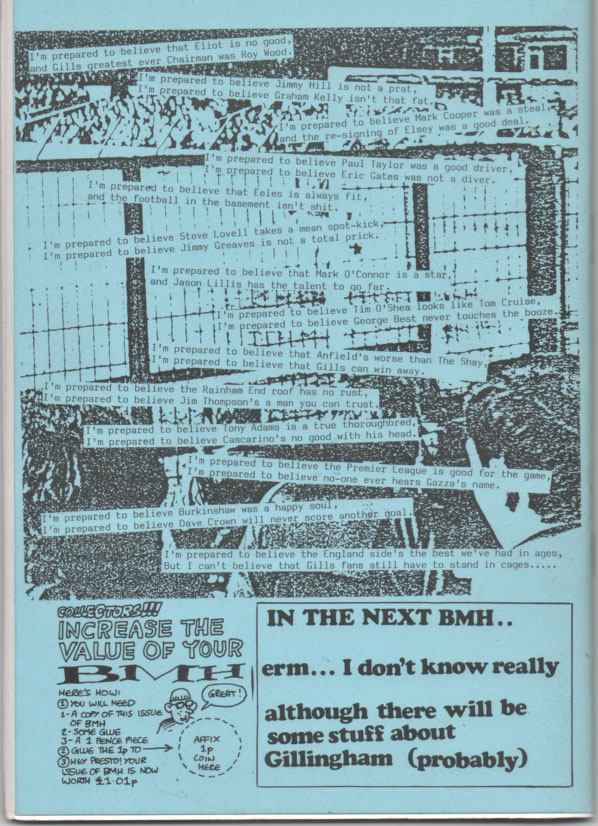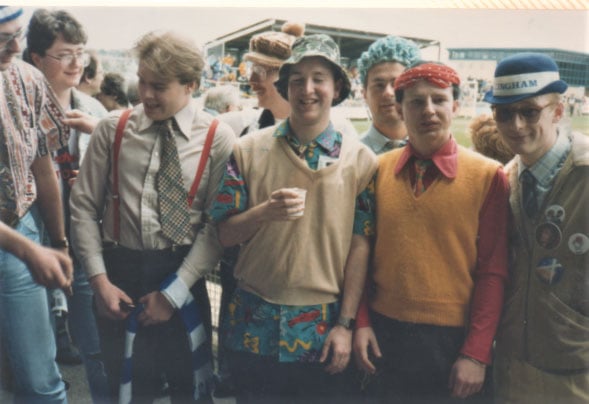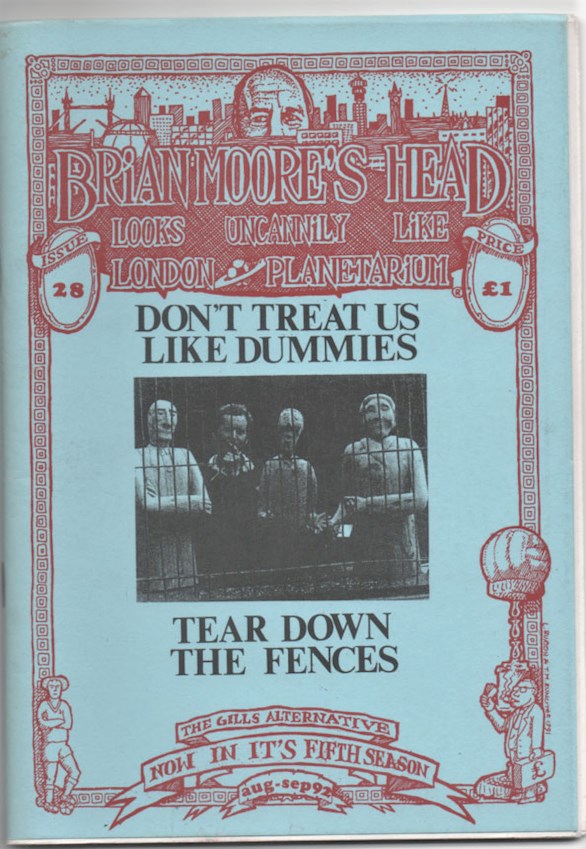Brian Moore’s Head was back, for a fifth season, at the beginning of 1992-93.
The fanzine’s launch, at the outset of 1988-89, had coincided with the start of a bleak period for Gillingham Football Club, with the Head having reported on four successive dismal campaigns, the first ending in relegation and then finishes of fourteenth, fifteenth and eleventh in Division Four.
The club were actually back in the third division for 92-3, but only because of the league restructure, with the first division becoming the Premier League, Division Two renamed Division One and so on. The new top flight was the subject of an article in BMH 28, the first edition of the 1992-3 season. The writer began by stating that if he had been told four years earlier that there would be no live football from the highest division, except on Sky television, then, as a football junkie in need of a regular fix, he would have been deeply concerned, ‘However, recent events have left me with a wry smile across my face, rather than a frown of consternation. In fact, on balance, it could be said that the main proponents of the breakaway Premier League; the greedy elitist, short-sighted chairmen, accountants and grey-suited idiots from the F.A. have shot themselves not only in the foot, but quite possibly in both knees as well.’
He went on to describe what the scenario had been over the previous few years, three big clubs; Liverpool, Manchester United and Arsenal and two not quite as big; Tottenham and Everton, ‘living in a land of sleeping giants, modest achievers and perennial strugglers who, just occasionally, would trouble the big guns by beating them at inopportune moments. In return for developing the vast majority of the young talent and providing employment for hundreds of players, the little clubs collectively had some say in how the whole league was run. They even took a modest share of the revenue generated by the big boys.’
The top clubs decided they wanted a larger share of the money available as they were the elite and they were faced with a crucial decision, whether to stick with terrestrial television for football coverage or sign up with the new satellite broadcaster, Sky. The lower three leagues had no say and it was just the-then first division clubs who got a vote. It was initially thought that BBC and ITV would team up in order to thwart Sky. However, ITV decided to go all out-for an exclusive deal, which was not surprising, given that they had been calling for change and had acted as a catalyst in the first place. The BBC was fearful of being frozen out but, without the necessary funds to generate its own deal, ‘then threw its hand in with Sky, reasoning that whatever they could get would be better than nowt – even if, in the long term, the BBC could be the biggest losers (along with the viewers) to the growth of Sky television.’
ITV offered £200M over four years, for live games and highlights programmes, whilst Sky and BBC came up with £304M covering five years, including Monday night live matches and the return of highlights programme Match of the Day on BBC1 on Saturday nights. It was then that some of the less-fashionable outfits in the top-flight expressed their preference for the Sky / BBC deal, ganging up on the so-called elite, with their choice not being popular with the big clubs, ‘Arsenal, Leeds, Manchester United, Aston Villa, Liverpool and others were furious. Live games on Mondays, potential over-exposure, fixture disruption and disgruntled season-ticket holders left the big boys fuming.’ The writer believed that the plotters had got what they deserved, citing that, in the previous season, ITV had averaged seven million viewers, peaking at around ten million, for their live Sunday afternoon matches, whilst Sky could only be reached by 2.8 million homes, described as pretty puny as terrestrial television had a reach of about 99% of the country.
The article continued, ‘Even if an extra million dishes were sold and they were all owned by football watchers, the numbers able to see live Premier League games in its inaugural season will be modest, to say the least. Converting new fans, young children and attracting potential floating viewers will become impossible without the flagship of a Sunday afternoon “event” beamed to the nation. Such events will only be available to those with money who, having bought a dish for the sport, will, in all probability, already be committed fans. How any extra interest or growth in the new Premier League will be generated is beyond me. Sponsors of ground advertising and shirts may be unhappy too, now that they will no longer have regular exposure for ninety minutes to ten million people. The price they are prepared to pay, particularly in a recession, might just be lower than those behind the breakaway may have expected.’
The writer also believed that ‘pay as you view’ TV was a concept that wouldn’t work as fans would not be prepared to pay £2-£5 extra to watch a run-of-the-mill game. He thought that only supporters of the competing teams would fork out, of which the majority of the keenest fans would be at the match anyway, with virtually no-one tuning in, ‘Television gives the oxygen of publicity to football, it creates interest and hype and enhances the game for millions who don’t actually go to matches. It also provides a superb showcase to advertise what can be an unbeatable product, but not if thousands, rather than millions, are watching.’ The author stated that, although the big clubs would each receive £0.5M per year, they would lose more than that in goodwill, interest, sponsorship money and exposure, and mentioned the sting in the tail, that the clubs in the lower divisions would be better off, ‘ITV have done a deal worth at least £25M, trebling what divisions two to four received beforehand. It involves Rumbelows (League) Cup coverage as before, regional highlights, a minimum of six live league games and also a facility for more live games that could be worth up to £50M over five years, with the attraction of truly nationwide exposure. Locally, Central TV are looking into screening thirty local live games, as are LWT and Tyne Tees. Hopefully, TVS and then Meridian will do likewise, but I doubt it somehow!’ The author believed that with the Premier League on Sky, ‘the net result is that the only football we are used to seeing, that we will now be spared, is the interminable Liverpool v Manchester United v Arsenal games and, frankly, they won’t be missed. The aforementioned teams have treated their fans, TV viewers and the rest of the League with utter contempt, and it will be refreshing to see a little variety. I think that it is deliciously ironic that the monster these big clubs created, and then unleashed, has turned the tables on them. So, despite all their plotting and conniving, they are less happy than when they were slumming it with the rest of us!’

After the end of the previous season, my plan had been to take a month off from fanzine work, but the break extended and it was mid-July before I was back working on BMH. It was still being typed by mainly Simon and myself and it took a phenomenal effort, with around four hundred pages produced during 1991-92. The first edition of 1992-93 alluded to the work put in, ‘My apologies in advance if this editorial may seem a little disjointed, as it is being written in the middle of the night, and totally without the aid of a safety net, in a desperate last-ditch effort to get the issue ready for the printers. Honestly, you have no idea what us poor overworked fanzine editors have to put up with.’ Going on to the subject of the new campaign, the editorial stated, ‘According to the local press, there is a buzz of optimism around Priestfield and season ticket sales are approaching record levels. Is it just me, or do they say that every year?! I have yet to meet a supporter who is either buzzing or optimistic, so where are these people? Well, excuse me for putting my cynical head on for a moment, but we have been hearing precisely this sort of nonsense for so long now, and without any sign of “our year” putting in an appearance, that I doubt any sane supporter really believes it.’
The summer of 1992 had seen a change in government policy regarding the implementation of the Taylor Report, with the relaxation of the all-seater requirement for clubs in the lower two divisions. At the time, the only seats at Priestfield were in the small Main Stand, with standing on the other three sides of the stadium. The article ‘Grounds for improvement’ regarded the change as ‘a rare piece of intelligent thinking from an administration that is less openly hostile to football than its immediate predecessors. Unfortunately, first and second division (or premier–first if you prefer) will still have to go all-seater because the government couldn’t totally lose face over the issue, even though the changes are patently unnecessary. The rules for teams promoted to the new first division will now allow a three-year period in which to go all-seater. Given the Gills’ record of never having got higher than division three in ninety-nine years, it is reasonable to think that we could be standing up at Priestfield in another ninety-nine years.’

The article reviewed the current basement division grounds, putting them into three categories. ‘The museum pieces’, those stadia that should be kept for posterity as charming, agreeable old relics, included Chesterfield’s Saltergate, ‘The archetypal lower division ground. Three thousand crowds bring atmosphere, oodles of space for away fans, near the Town Centre for pubs and transport – really ideal. Perhaps a modest cover on the away end would help.’ Also in the same category was Priestfield, ‘Rundown, bitty, but still home sweet home. Apart from the unnecessary fencing, should be left untouched. I want to stay put! If I were pressed to change it, I would make the Rainham End steeper, the roof rust-proof, fill in the Gordon Road crater with covered terrace and extend the Main Stand to cover the whole length of Redfern Avenue.’ Those grounds deemed to have ‘room for improvement’ included the Bescot at Walsall, ‘Brand new, but oh so dull. One side should be redesigned to give it some character and personality. Clean, efficient, but also antiseptic. Unlovable’, and Carlisle’s Brunton Park, deemed to be very respectable except for the side housing the away enclosure, which had an obtrusive fence and too many poles holding up the roof. With the stadium around 350 miles from Gillingham, it was deemed that ‘Carlisle would greatly benefit from moving their ground and I, for one, suggest that a groundshare with Chatham Town would be ideal.’ Finally, there were eight ‘grounds only fit for demolition’, of which most have since been demolished, with only one out of the eight, Scunthorpe’s Glanford Park, both still in existence and hosting Football League matches.
The 1991-92 season was summed up with ‘facts and stats’, including ‘miles from seafront of Scarborough’s ground, 3’,’miles off his line of Harvey Lim for Scarborough’s winner, 4’ and ‘Scarborough supporters present, 5’. One particular Gillingham fan received stick with respect to the away game at Field Mill, with the number of Gills supporters who travelled to Mansfield on the M1 given as 150, with the A1 total 4, the number of fans stuck in an horrendous traffic jam on the way to Mansfield, 4 (guess which ones), and the Gills fans not letting Stuart decide the route ever again numbering three.
The ‘Brian Moore’s Head Looks Uncannily Like London Planetarium Guide To Division Three’ previewed upcoming away matches, with helpful hints that may or may not have been made up, ‘Bury spelt backwards is Yurb. The Yurb bird of Central Borneo lays the largest eggs of any bird in the Indian Ocean / Australasian area. In 1966, Mrs Emily Bagshott of Darwin found a specimen which weighed in at 4lb 8oz. It took 35 minutes to boil. Mrs Bagshott died of cholesterol poisoning in 1971.’ Also included was ‘How to get there’, ‘Scarborough has two funicular railways, one on the north cliff and one on the south cliff. These are very convenient if you intend travelling to Scarborough by boat. Note, the south cliff funicular offers no buffet service at weekends.’ There was information on pubs and food and drink and a ‘Give it a miss’ category which, for Northampton, read, ‘The food at the County Ground is burnt and overpriced, and that’s just the tea.’ The guide also featured ‘Don’t blame us’, including a disclaimer, ‘Brian Moore’s Head, its friends and associates accept no responsibility for any inaccuracies in this information, which is provided in good faith. For example, if you get beaten up in a pub which we said was quaint and bijoux, or find that the castle in Cardiff has been knocked down and replaced by a Watney’s theme pub, we sympathise but accept no blame.’
Still priced at £1, BMH28 ran to 72 pages and was out for the season’s opener, a 2-3 home defeat against Northampton Town, when the visitors scored a last-minute winner.
